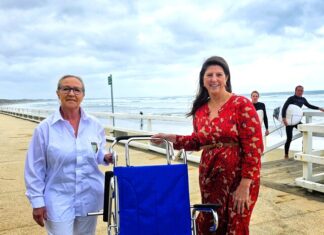Andrew Mathieson
The ‘T’ in Hugo T Armstrong’s name could just as well stand for trains.
But that would also then require a second middle initial of B for the Blues.
In Hugo’s world, red rattlers and soulful tunes don’t exist without the other.
The founder of Queenscliff’s Blues Train loves to drift off to a bygone era and envisage the Deep South of America when the rolling of musical rhythms combined with the natural chugging of steam engines.
“Blues musicians would hitch a ride on a steam train to get around from town and town,” Hugo explains.
“So there has always been a synergy between the music and trains – I mean, how many blues songs are there about trains? There are a lot.
“The make-up of the music fits in well with the confines of the train, physically – you couldn’t do a jazz ensemble because it’s rattling around and moving.
“But the rawness of rhythm and blues music fits.”
That fuzzy image was turned into reality 18 years ago when a couple of trainspotter mates wanted to start shovelling coal again into some early 1900s steam locomotives abandoned in the old Fyansford quarry.
Hugo’s own love affair with rail travel stretches back to when grandma would roll into Queenscliff station in a rattling train from Melbourne.
It even dates back to memories from Point Lonsdale kindergarten where he and other kids would climb up on the safety fence and encourage the passing train driver to blow his whistle for their amusement.
“A lot of people don’t realise that the Fyansford fleet (which carries the Blues Train) is a really significant train that has come to Queenscliff,” the 43 year old adds.
“This is Geelong’s rail history; trains that are our living history, they’re still going and they’re not sitting in a museum.”
Spicing up the ride with the blues was a masterstroke of the community radio station DJ, who last week finished 21 years on air.
Each of the Blues Trains’ four carriages hosts a different musical genre performed by a different band or artist.
The crowd swaps carriages every half hour to get a new taste of the blues – and of its meals.
“I never envisaged when we first started we’d still be here doing it now,” Hugo reflects.
“There’s nothing like this in the world, so people come from all over Australia to do it.”
Hugo would be the first to admit his love of the blues has gone off the rails – and into the home.
His three-storey Point Lonsdale house is overwhelmed with memorabilia reflecting the atmosphere of a blues bar. Lava lamps, neon signs and stacks of vinyl records are among a myriad of things to dazzle the eye.
“I’ve slowed down these days…I’m thinking it’s time for a garage sale,” Hugo laughs.
What stands out the most among the clutter is an obscure TV Logie. It sits on top of his television, staring back every day when Hugo sits down.
He owns the statuette but it’s not really his. A guy who worked at the factory where the Logies are crafted decided to add to Hugo’s rare array of collectables.
“There’s no guilt because it doesn’t belong to anyone,” he quips.
“I have this Logie, it’s really heavy and it sits on top of the TV – where else would you put a TV Week Logie?”
Then, for Hugo, there’s the kite world.
A hidden part of his alter ego, it was more than just child’s play when he owned a kite shop in Point Lonsdale.
There was also a time when Hugo was the national stunt kite champion, flying two-string sport kites to rhythmic music and in perfect formation, like Olympic synchronised swimmers.
Hugo interrupts to corrects the analogy.
“The speed our kites we were flying at, it was more like the Roulettes,” he smiles.
Get the latest news to your email inbox FREE!
REGISTER





